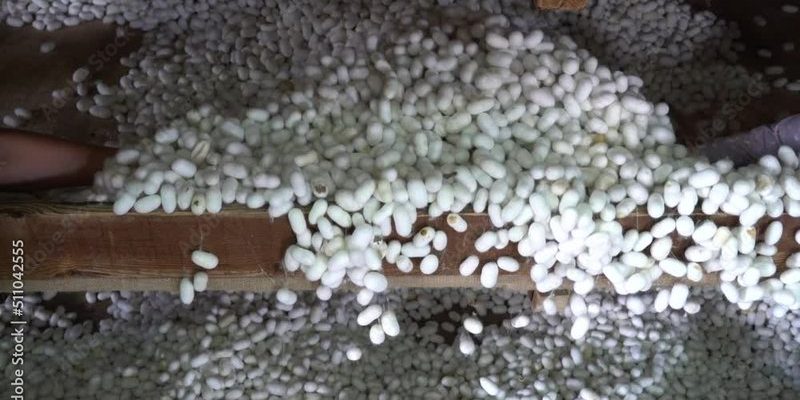
Silkworms, primarily the *Bombyx mori*, are the stars of the silk production world. They spin their cocoons, which are harvested to make silk, a material that’s been valued for centuries. You might be wondering why it’s essential to prepare them properly. Well, if you skip steps or get the environment wrong, you could end up with fewer cocoons or lower-quality silk. So, let’s dive into how to ensure your silkworm production is smooth and successful!
Understanding the Life Cycle of Silkworms
Before you can prepare silkworms for cocoon production, it’s crucial to understand their life cycle. Silkworms go through several stages: egg, larva, pupa, and adult moth. Each stage has its unique requirements and characteristics.
1. **Egg Stage**: The journey begins with tiny eggs, often laid by a female moth. Once the eggs hatch, usually within 10 days, they enter the larval stage.
2. **Larval Stage**: This is the most critical phase for farmers. Silkworms will grow rapidly, shedding their skin multiple times (up to five times!). Each time they shed, they require an abundance of mulberry leaves. Keeping them well-fed is essential for healthy growth.
3. **Pupal Stage**: After reaching full size, silkworms will spin their cocoons. This can take anywhere from 2 to 3 days. It’s during this period that they transition into pupae, making it a vital time for farmers.
Understanding these stages helps you plan out the timing of your production cycle, ensuring everything aligns for maximum output.
Setting Up the Right Environment
Creating the perfect environment for silkworms is essential for successful cocoon production. Here are the key factors you need to consider:
– **Temperature**: Silkworms thrive in temperatures between 25°C to 28°C (77°F to 82°F). Too hot or too cold, and you might stress the worms, leading to lower production.
– **Humidity**: Maintaining humidity levels around 60-70% is crucial. If it’s too dry, the silkworms can dry out, and if it’s too humid, they might develop diseases. Think of it like keeping a plant alive—too much or too little water and it struggles!
– **Ventilation**: Good airflow is crucial to prevent the buildup of odors and humidity. Stagnant air can lead to health problems, so consider installing fans or ensuring there are enough openings for air exchange.
By mastering these environmental elements, you’ll set the stage for a thriving silkworm population ready to produce cocoons.
Feeding Silkworms Properly
Feeding is where many new farmers stumble. Silkworms are not picky eaters, but they do have specific dietary needs. Here’s what you need to know:
– **Mulberry Leaves**: The primary food for silkworms is fresh mulberry leaves. They should be free from pesticides and pesticides, as these can harm the worms.
– **Quantity**: As the silkworms grow, their appetite increases dramatically. It’s important to calculate how much food you’ll need based on the number of worms you have. On average, each silkworm can eat up to 30 grams of leaves over its lifetime.
– **Feeding Schedule**: Young silkworms require feeding several times a day, gradually reducing to fewer meals as they grow. Keeping a consistent feeding schedule helps keep the silkworms healthy and promotes vigorous growth.
By paying attention to their diet, you’ll take a giant leap toward ensuring a robust yield of high-quality cocoons.
Pest Control and Disease Prevention
Like any farming endeavor, raising silkworms comes with its challenges. Pests and diseases can quickly become a nightmare if not managed effectively. Here are some strategies:
– **Regular Checks**: Inspect your silkworms daily. Look for signs of disease, such as discoloration or abnormal behavior. Early detection is key!
– **Clean Environment**: Keep their environment clean by removing uneaten leaves and waste. This practice helps reduce the risk of diseases spreading among your silkworms.
– **Natural Remedies**: If you notice pests, consider using natural remedies instead of harsh chemicals. Sprays made from neem oil or insecticidal soaps can be effective without harming the worms.
Taking pest control seriously can save you a lot of heartache, ensuring your silkworms stay healthy and productive.
Harvesting Cocoons Wisely
Once your silkworms have spun their cocoons, it’s time for the exciting part: harvesting! But it’s important to do it right. Here’s how to approach it:
– **Timing**: Wait until the cocoons are dry and firm, which usually takes about 2-3 days. Harvesting too early can damage the silk.
– **Careful Handling**: When collecting the cocoons, handle them gently. They are delicate, and rough treatment can lead to broken silk threads, reducing quality.
– **Storage**: Store harvested cocoons in a cool, dry place. Ideally, keep them in a breathable container to prevent mold and damage.
Taking care in this stage can significantly influence the quality and viability of the silk you produce.
Processing Cocoons into Silk
After harvesting, your cocoons need to be processed to extract silk. This involves a few steps:
1. **Boiling**: To extract the silk, boil the cocoons in water. This softens the sericin, a natural gum that holds the silk fibers together.
2. **Reeling**: Once boiled, the silk threads are carefully unraveled from the cocoons. This step requires skill to ensure long, continuous strands are collected without breaking.
3. **Dyeing and Weaving**: After reeling, silk can be dyed and woven to create beautiful fabrics. This stage opens up a world of design possibilities!
Processing your cocoons with care is crucial. It’s the difference between producing high-quality silk products and losing out on profit.
Preparing silkworms for commercial cocoon production is truly an art. It involves a blend of science, patience, and a bit of creativity. Each lifecycle stage, from feeding to harvesting, requires attention and care.
By understanding their needs and creating the right environment, you can set yourself up for success. Remember, the journey from silkworm to silk is all about nurturing and protecting these fascinating creatures. So, roll up your sleeves, and dive into the rewarding world of sericulture. With dedication and effort, you’ll find that the rewards—both in terms of silk quality and satisfaction—are well worth it!

